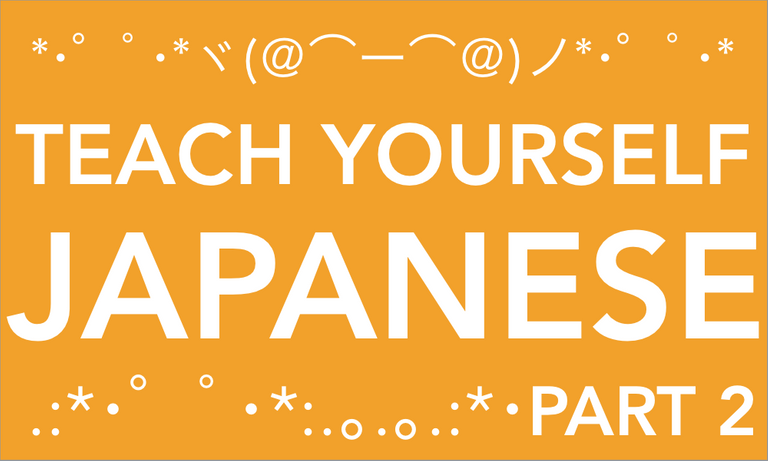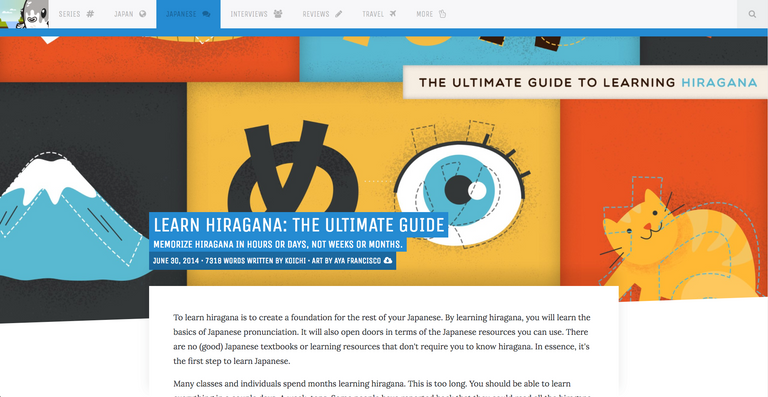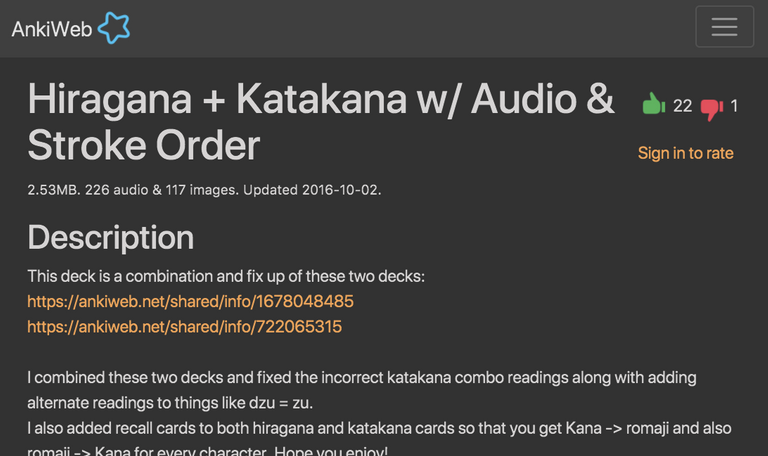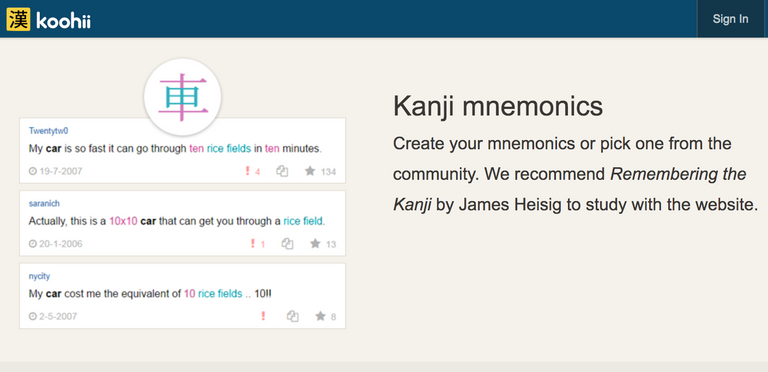
Posts in this series: Part 1 / Part 2 / Part 3 / Part 4 / Part 5
Remembering the Kana
The first task with Anki will be to learn the kana (hiragana and katakana). Personally, I used a book called Remembering the Kana to learn how to read the them, but I’d recommend using the following free resources coupled with Anki instead:

Remembering the Kana and these Tofugu guides both use mnemonic devices to help turn the curious little squiggles used in Japanese into something you can actually remember. That’s going to be a common theme in this guide. We need to give your brain some context so that it can remember all of these things that are so new to you.
You’ll want to make a pass or two through these guides, and then reference them as necessary. When you start reviewing the guides, also download Anki and this shared deck and start reviewing them.

I would recommend writing out each character as you review them to create some muscle memory. They all have a specific stroke order, so make sure to reference these charts for hiragana, and these charts for katakana to see the proper way to write them.
Unfortunately, Anki isn’t the most intuitive app to use, so please just let me know in the comments if you have any trouble getting it set up. Here’s a quick guide to get you started.
Pacing Reviews
Something you’ll quickly realize when using Anki is that cards due for review can pile up pretty quickly if you study too many new things each day. In the beginning it doesn’t feel like you’re doing much so you’ll try to get through as much new content as possible, but keep in mind that the workload will quickly become overwhelming.
A good rule of thumb is to do no more than 10 new cards per day. This will feel excruciatingly slow in the beginning if you’re excited to make progress, but if you’ve done all of your reviews for the day and want to do more, just study outside of Anki. Review the kana charts I linked to above, or do some of the other activities I talk about later in this guide for practicing Japanese vocabulary and grammar.
Remembering the Kanji

Learning the kanji will take some more time, but we’re going to basically take the same route as with the kana.
The hardest thing about the kanji is finding a way to make them more “sticky.” Unless you already have some familiarity with kanji or Chinese characters, it will be really hard to remember them because there’s nothing for your brain to grab onto — they’re just too different from anything else you know.
I recommend checking out the book Remembering the Kanji along with a site called Reviewing the Kanji (free) and this Anki deck (also free).
Another alternative is Wanikani which is a subscription service that costs $9 a month at the time I’m writing this article. It’s very similar to Remembering the Kanji (RTK), but it’s in a bright and easy to use package with Tofugu’s brand of humor and style. I haven’t used it extensively myself but I’ve heard good things.

The general idea with RTK is to break down the pieces that make up a kanji into different parts, and then make an imaginative story to link them together.
Here’s the home page of Reviewing the Kanji with a sample of what I’m talking about:

At the top we see the character 車. Below it is a “story” that reads “My car is so fast it can go through ten rice fields in ten minutes.” “Ten” and “rice fields” are both highlighted corresponding to parts of the character that are highlighted. This is because 十 is the character for ten and 田 is the character for rice field. We link these up in the above story to help us remember the keyword “car.”
The best way to get this to stick is to visualize in your head a car racing through ten rice fields in ten minutes. This visual story is what will really improve the rate at which you can learn and remember the characters.
We break down the character into what are referred to as “primitives” (十 and 田). Some of these will get their own stories to help you remember them, and some will be relatively easy to remember based on the way they look.
It might seem weird that we’re not learning how to read the kanji at this stage, but we’ll focus on learning the readings in context. A really frustrating part of Japanese is that the way the characters are read can vary widely depending on the context. One kanji might have several different readings depending on which word it is used in.
And that’s it for part 2. 🙂 In the next part we’ll take a look at actually learning some Japanese words!
I hope this was helpful and don’t forget to let me know in the comments if you have any questions!
Posts in this series: Part 1 / Part 2 / Part 3 / Part 4 / Part 5
Looks like some good resources! Did you have a personal favorite when starting out?
I personally just used pencil, paper and textbooks! I think being able to write really helps with remembering too. But theses resources are certainly useful, too.
Not a fan of Wanikani's all 2000 kanji / 6000 words claim. X numer of kanji isn't a useful metric - some are much more common than others, what is more important is the number of words you can use effectively and sentences you can make.
Still, solid post and great tools.
In the beginning I was just really into using Anki for whatever I could :P So I studied pretty much everything in there, but later on I started using pen and paper much more. To be honest I wish I spent more time away from Anki, especially in the beginning, because I had a hard time managing reviews after awhile. But there's still something about adding cards and seeing my decks get bigger that can keep me coming back more than pen and paper can.
Yeah I agree that learning X number of kanji isn't a useful metric. I found it really helpful getting exposed to a lot of them in the beginning though because it helped me build up my mental model and start to recognize them as groups of radicals instead of a bunch of random lines. I know what you're saying though -- I tended to (and still tend to) focus a little too much on numbers, and if I put more time into focusing on building up certain gaps in my knowledge that need to be filled I'd probably be at a higher level right now.
Thanks for the comment! Always fun talking about Japanese learning methods :P
Really creative and comprehensive resource on Japanese that you're creating here @jeffbernst, thanks for creating this and sharing your insight!
It has been a ton of fun creating it :D Thanks for the support!
It's been awhile since a learned japanese back in high school. I'm planning on going to Japan this year and I need all the help I can get. Thank you for sharing this @jeffbernst.
No problem! Good luck with your studies and have fun in Japan :)
Respect Jeff, that seems like a daunting endeavor.
:-) @roused
Congratulations @jeffbernst! You have completed some achievement on Steemit and have been rewarded with new badge(s) :
Click on any badge to view your own Board of Honor on SteemitBoard.
For more information about SteemitBoard, click here
If you no longer want to receive notifications, reply to this comment with the word
STOP